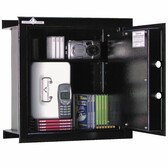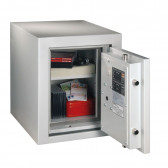Having a safe at home is increasingly common. There are a number of reasons for this, the most common being the increasing affluence of society and the growing awareness that valuables need to be kept safe; from a pessimistic point of view, possibly that war, chaos and doom are on the way and hordes of villains are lurking about our possessions.
Be that as it may, the idea of having a safe in one's home or flat is becoming more and more common. Among our clients, quite a few of whom have no experience with safes, a popular idea is to hide the safe from view. A hidden safe, they infer, will be secure.
Whether this is the case and why, we will inform you in the following text.
What can you hide in a safe?
Many items of material or sentimental value that you want to protect from theft, fire or damage can be stored in a safe. Here are some examples:
Documents:
• birth, marriage and death certificates,
• passports and identity cards,
• contracts and other important legal documents,
• wills and deeds,
• photographs and memorabilia.
Valuables:
• cash, jewellery, valuables,
• works of art and collectibles,
• gold bars and other precious metals.
Electronic devices:
• laptops and tablets,
• data carriers such as hard drives and memory sticks.
Weapons:
• firearms and ammunition,
• sporting weapons, bang guns, signal weapons.
Other items:
• drugs and narcotics,
• substances which are dangerous for some reason,
• souvenirs and other items of sentimental value.
From what does the security of a safe derive?
There are several factors that make the contents of your safe secure, all of which, cumulated together, make up the security of your property.
Security class
The first and most important aspect of the matter is the security class that a particular safe can claim. What does this mean? Depending on the complexity of the safe's design, the time required to break through the door or body increases. The better the safe, the more difficult and longer it takes to carry out a successful burglary.
In our range of safes you will find safes in different classes: from basic S1 and S2 according to EN 14450 to classes I-V according to EN 1143-1.
Weight of the safe
If we assume that burglary on the spot will not be that easy, then the second decisive factor is the weight of the safe. The higher the weight, the less likely it is that unauthorised people will take the safe with them to a place where they have an unlimited amount of time at their disposal.
It is reasonably secure to assume that the risk of the safe being taken away drops dramatically with safes weighing 100 kg or more.
Installation
However the safe is built, as long as it weighs less than 1,000 kg, it must be permanently mounted to a structural element of the building, i.e. floor and/or wall. The procedure is similar to that for assembling cabinets: the safe is placed in its intended location, whereby – unless there are major obstacles, this can be in a cupboard, desk or other enclosure – the locations of the mounting holes are marked, the anchor (steel or chemical) is hammered in and tightened with a screw.
However, you don't have to worry about assembly – we undertake this type of service.
Read also: Installing a safe versus building a smart home. Check what you need to know
An invisible safe
OK, but what about the hiding? As you may have noticed, there is not a word in the above list about hiding anything and this is for a reason. Locating a safe in a wall, floor or other place that is not visible at first glance does not directly affect security, but rather is a way to make it comfortable to use in everyday life.
However, if for some reason a so-called invisible safe is a priority for you, furniture safes, wall safes or floor safes can be a good choice.
Furniture safes
One of the simpler variations on the theme of the concealed safe is a safe that you mount inside a built-in piece of furniture. A hidden safe can be a safe in a desk, cabinet, wardrobe, etc. There are various products in this category, not necessarily the lightest and simplest, although I admit that a fairly common choice when buying such a little one, which is more like a locker than a safe, is the lowest price. However, this is sometimes a compromise that can become overly rotten and customers expecting the highest quality should avoid such products.
Wall safes
The most obvious way to hide a safe from a burglar, at least in theory, is a wall-mounted safe. Wall safes have several advantages: they can actually be hidden behind a painting (which is so obvious that it might actually confuse someone), and they do not take up valuable space in the room. However, there are also disadvantages.
While you can choose almost any size you want, wall safes are limited to a maximum of burglary class I. That's not bad, but I wouldn't keep larger cash, serious valuables or jewellery in there. There is also no fireproof option, so if you need a safe not only for money but also for storing documents, wall safes are not the best.
It's also important to note that wall safes only have a decently armoured door, the rest is a single-wall construction that happens to be found in the cheapest S1 class safes. For this reason, even a large and heavy safe is generally easy to break out of.
Floor safes
Floor safes have all the features of wall safes, but with one undisputed advantage which is also the biggest disadvantage: getting into them is very difficult, to say the least. Because the door is covered with boards, parquet or panels on the floor, even the owner will have limited access to the floor safe.
Summary
All right, but does it even make sense? It doesn't. The invisible safe is an industry myth (albeit... we offer one ourselves) that is based on the illusory belief that a burglar will not find it. He will find it, if he takes a risk and starts a burglary, he will sweep through everything (time permitting) and it is naïve to assume that he will not notice this one place.
A hidden safe therefore has one positive – it saves space. However, if you have a little space and are interested in top-quality products, contact us – we will discuss everything in turn: available options, prices, shipping and installation conditions. We invite you to visit our showroom and office!
Check out: 7 unusual places where you can hide a safe






